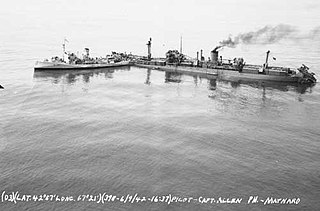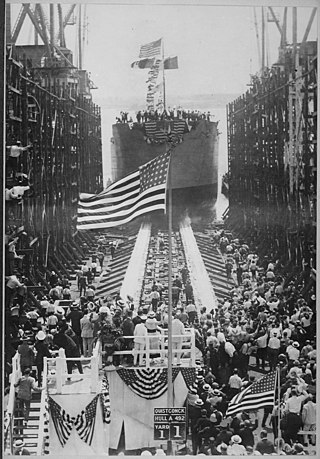SS Savoia was a cargo steamship that was built in Italy in 1922. In 1941 the Royal Navy captured her, and the UK Ministry of War Transport renamed her Empire Arun. In 1947 she was sold and renamed Granlake. With further changes of owner she was renamed Dryad in 1949; Shiranesan Maru in 1951; and Dainichi Maru in 1962. The romanised spelling of her name had been revised to Tainichi Maru by 1967. She was scrapped in Japan in 1969.
Empire Baron was a 5,890 GRT cargo ship which was built in 1926 for Navigazione Generale Gerolimich & Compagnia Società in Anzioni, Trieste, Italy. She was captured by the Royal Navy in 1940 and ownership passed to the Ministry of War Transport (MoWT). She was renamed Empire Baron. She was sold in 1947 to Navigation & Coal Trade Ltd, London and renamed Rubystone. She was sold to a Panamanian company in 1951 and was scrapped in 1960.
Empire Carpenter was a 7,025 GRT cargo ship which was built in 1942 for the Ministry of War Transport (MoWT). In 1944 she was leased to the Soviet Union and renamed Dickson. In 1946, she was returned to the United Kingdom and regained her former name of Empire Carpenter. She was sold in 1947 and renamed Petfrano. In 1955, she was sold to Panama owners and renamed Amipa, further sales saw her renamed Apex. In 1968, she was sold to Cypriot owners and renamed Afros, serving until scrapped in 1971.
Derwentfield was an 8,602 GRT tanker that was built as Empire Coral in 1941 by Sir J Laing & Sons Ltd, Sunderland, United Kingdom. She was built for the Ministry of War Transport (MoWT). In 1946, she was sold into merchant service and renamed Derwent River. Another sale in 1947 saw her renamed Derwentfield. She served until 1952 when she was severely damaged by an explosion and subsequent fire. In 1953, she was declared a constructive total loss and scrapped.

Philips Wouwerman was a 7,091 GRT cargo ship that was built in 1942 as Empire Courage by Barclay, Curle & Co Ltd, Glasgow, United Kingdom. She was built for the Ministry of War Transport. in 1943, she was transferred to the Dutch Government and renamed Philips Wouwerman. In 1947, she was sold into merchant service and renamed Ceram. A further sale in 1953 saw her renamed Amsteltoren and then Amstelbrug. In 1959, she was sold to Greece and renamed Armathia. A further sale in 1965 saw her renamed Calliman. She served until scrapped in 1968.
Empire Deed was a 6,766 GRT cargo ship that was built in 1943 by Bartram & Sons Ltd, Sunderland, Co Durham, United Kingdom the Ministry of War Transport (MoWT). In 1946, she was sold into merchant service and renamed Deed. In 1951, she was sold to Panama and renamed Doro. A sale to Greece in 1956 saw her renamed Leonidas Cambanis. In 1964, she was sold to Liberia and renamed Ever Fortune followed by a sale to Taiwan later that year and renaming to Ever Happiness. She served until 1967, when she was scrapped at Kaohsiung, Taiwan.
Esso Appalachee was a 9,819 GRT tanker that was built in 1942 as Empire Dickens by Furness Shipbuilding Co Ltd, Haverton Hill-on-Tees, County Durham, United Kingdom for the Ministry of War Transport (MoWT). In 1946, she was sold into merchant service and renamed Esso Appalachee, serving until 1960, when she was scrapped.
Norholm was a 9,813 GRT tanker that was built in 1942 as Empire Druid by Sir J Laing & Sons Ltd, Sunderland, Co Durham, United Kingdom for the Ministry of War Transport (MoWT). In 1942, she was transferred to the Norwegian Government and renamed Norholm. She was sold into merchant service in 1946, and renamed Haukefjell. Fitted with a new engine in 1949, she was sold to Panama in 1952 and renamed Bluewater. She served until 1959, when she was scrapped in Japan.
Empire Duke was a 7,067 GRT cargo ship that was used during the Second World War in investigations into the metallurgical problems that Liberty ships were suffering from.
Verna Paulin was a 7,046 GRT cargo ship that was built in 1942 as Empire Envoy by Short Brothers Ltd, Sunderland, Co Durham, United Kingdom for the Ministry of War Transport (MoWT). She was sold into merchant service in 1946 and renamed Cheltenham. A further sale in 1952 saw her renamed La Orilla. A sale to a Swedish company in 1955 saw her renamed Stallberg. In 1958, she was sold to a Finnish company and renamed Verna Paulin. She served until 1969, when she was scrapped.

Kronprinsen was a 7,078 GRT cargo ship that was built as Empire Fairbairn in 1942 by Barclay Curle & Co, Glasgow, Renfrewshire, United Kingdom for the Ministry of War Transport (MoWT). She was transferred to the Norwegian Government before completion and renamed Kronprinsen. She served until 9 June 1942, when she was torpedoed and damaged by U-432 off Cape Sable Island, Nova Scotia, Canada. She was under repair until October 1943.

Empire Faith was a 7,061 GRT CAM ship that was built in 1941 by Barclay Curle & Co, Glasgow, Renfrewshire, United Kingdom for the Ministry of War Transport (MoWT). Converted to a cargo ship in 1943, she was sold to a British company in 1946 and renamed Jessmore. In 1958, she was sold to a Panamanian company and renamed Antiope. A further sale in 1964 saw her renamed Global Venture. She served until 1971, when she was scrapped.

Quistconck was a 5,144 GRT Design 1022 Hog Islander that was laid down as Red Jacket in 1918 by the Stone & Webster subsidiary American International Shipbuilding Corp., Hog Island, Philadelphia, Pennsylvania, United States for the United States Shipping Board (USSB). Launched as Quistconck, she was sold to Lykes Brothers - Ripley Steamship Co Inc in 1933. In 1941, she was passed to the Ministry of War Transport (MoWT) and renamed Empire Falcon. She was sold into merchant service in 1946 and renamed Barnby. A sale to a Panamanian company saw her renamed Mariandrea. She served until 1953, when she was scrapped.
Jolee was a 5,500-gross register ton (GRT) Design 1022 cargo ship that was built in 1920 by American International Shipbuilding, Hog Island, Philadelphia, Pennsylvania, United States for the United States Shipping Board (USSB). Launched as Cardington, She was completed as Jolee. She was sold in 1933 to Lykes Brothers - Ripley Steamship Co Inc. She was purchased by the Ministry of War Transport (MoWT) in 1941 and renamed Empire Flamingo. She served until June 1944 when she was sunk as a blockship at Juno Beach.
Graigaur was a 7,047 GRT cargo ship that was built in 1941 by Swan, Hunter & Wigham Richardson Ltd, Newcastle upon Tyne, Northumberland, United Kingdom, as the CAM ship Empire Foam for the Ministry of War Transport (MoWT). She was sold in 1946 to Graigaur Shipping Co Ltd and renamed Graigaur. She was sold in 1957 to Marinos & Frangos Ltd and renamed Maltezana. She was sold to the Great Southern Steamship Co Ltd., Hong Kong in 1958 and renamed Johore Bahru, serving until she was scrapped in 1963.
Stad Schiedam was a 6,140 GRT cargo ship which was built in 1942 as Empire Fortune by John Readhead and Sons Ltd, South Shields, County Durham, United Kingdom for the Ministry of War Transport (MoWT). She was transferred to the Dutch Government in 1943 and was renamed Van Honthorst. She was sold to the Halcyon Lijn in 1945 and renamed Stad Schiedam, serving until she was withdrawn in 1961. She was scrapped in 1962.
Hazelbank was a 6,140 GRT cargo ship built in 1942 as Empire Franklin by John Readhead and Sons Ltd, South Shields, County Durham, United Kingdom for the Ministry of War Transport (MoWT). She was converted to a CAM ship shortly after completion. She was sold to Bank Line in 1945 and was renamed Hazelbank. She was sold Compagnia Navigazione Nuevo Mundo SA, Panama in 1957 and renamed Irinicos. She was sold to Paleocrassos Bros, Greece in 1962 then to Salinas Compagnia Navigazione SA, Panama in 1963 and was renamed Iris II, serving until 1967 when she was scrapped in Hong Kong.
Redgate was a 7,131 GRT cargo ship which was built in 1945 as Empire Freetown by Burntisland Shipbuilding Co. Ltd., Burntisland, Fife, United Kingdom for the Ministry of War Transport (MoWT). She was sold to B J Sutherland & Co. Ltd. in 1946 and was renamed Inverness. She was sold to Turbull, Scott & Co. Ltd. in 1957 and renamed Redgate. She was sold to Compagnia Marvalia Navigazione SA, Monrovia, Liberia in 1963 and was renamed Agia Elpis. She was sold to Southern Cross Shipping Co. Ltd., Cyprus in 1967 and was scrapped in Shanghai, China in 1968.



